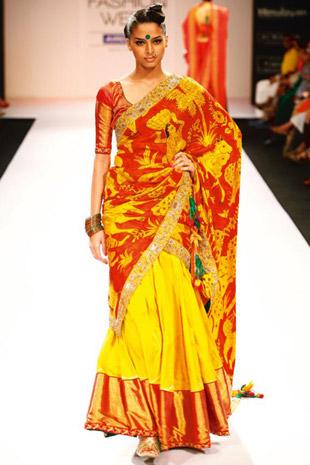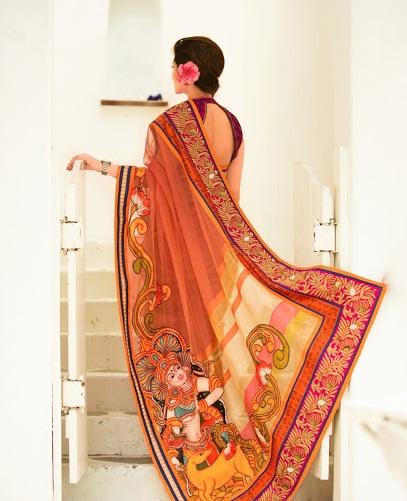
Painted Silk
Painted Silk refers to the silk fabric which is painted upon in vibrant colors. A hand-painted silk attire can be a stylish addition to your wardrobe. Widely used in on silk Sarees it makes the attire more lively with the vivid colors. The naturally shiny surface of silk makes it perfect to use as a canvas for painting.
Background
It is believed that the Chinese introduced Silk in the 27th century BC and remained exclusive to China until the famous Silk Road opened during the first millennium BC, opening thousands of miles of interconnected trade routes across Asia, Africa and Europe.
Besides Silk, Paper and other goods, the Silk Road carried other products which were equally significant in world history. Along with trade and migration, the world’s oldest international highway was the medium which spread Buddhism through Central Asia.
Silk painting preceded the invention of paper like the embroidery technique in silk. The ancient art was once known as ‘Bo’ painting, referring to the white silk used as a surface. Silk was the ideal canvas for painting in comparison to wood, stone or bamboo at that time. It was rich and yet easy to alter to any desired shape and light to carry.
Earlier, Chinese artisans prepared the Silk cloth by beating it against stone to smoothen the surface before applying color. Using animal hair paintbrushes, ink mixtures of soot and glue, or mineral pigments of vermilion, azurite and malachite, ancient Chinese artists created works of art that have survived centuries.
Around 300 AD, the Japanese acquired the methods of Silk painting from the Chinese. Their early Silk paintings were monochromatic, using black ink and paint. Around 1300 AD, Japanese artists began to use an array of colored pigments. It wasn’t until the 12th century with the conquests of the Crusades, did Silk production began to spread to Western Europe. New manufacturing techniques saw Silk production boom, and Italy established itself as a major European hotbed for Silk. Silk painting spread as an art form by the 18th century, as the industrial revolution made the cloth even more widely available.
Silk painting traces back to the 2nd century AD, when wax resist method for decorating Silk was used. Silk painting in India touched great heights during Mughal rule in 17th – 19th centuries. It was by and large practiced in Rajasthan. Paintings and portraits on Silk for articles of decoration became trendy.
Themes of Silk painting vary from simple birds, animals, and flowers to delicate flower-patterned motifs, designs, landscapes, culture paintings and mythological figures. They also depicted beautiful women. A superior effect is produced with use of gemstone and gold powder. Brilliant and glowing colors further enhance its richness. Today a multitude of silk painting styles and techniques abound, and the art can be found all around the world.
The Making
Painting on Silk begins with a luxurious base of precious pure white China silk stretched tightly and secured on a frame. An applicator bottle of Gutta or Gutta type of resist is held with its tip against the fabric and squeezed gently to achieve a pattern. Gutta (a rubbery kind of cement) and water-based resists are popular for sketching the outlines of designs on the Silk. The desired shape has to be closed completely without a break so that any amount of dye cannot escape. With a soft brush, foam brush or applicator nib the dye is applied sparingly to the center of the design allowing the fabric to absorb it. After it is dry, it has to be fixed with method prescribed for the dye or paint that is used. The purpose of a resist is to stop the flow of dye and create a barrier, which makes the outline of an image. After the painting is complete the silk is steamed for many hours. This sets the dye and increases the intensity of the color. It also makes the painting permanent and durable.
There are definite special effects that can be produced in Silk painting with use of certain techniques. Water-like effects can be attained by applying paints or dyes using eye dropper, mist sprayer or other tools that generate the abstract effect. By sprinkling salt on damp silk and brushing it off when it is dry gives appealing textural effects. Various sizes of salt crystals, yielding different effects are there.
By applying alcohol to the dye painted silk, beautiful effects on the paint are created. It helps to produce contrasting lighter and darker spots.
Variety
A great variety of Silk fabrics in different weights can be used for Silk painting. Some of the Silk fabrics that can be painted upon are Silk Habutai, Pongee, Paj, Silk gauze, Silk dupion, Silk twill, Raw silk, Flat crepe, Crepe back suit satin, Silk organza, Silk chiffon, Crepe de chine, Decore satin and Silk velvet.
Present Day Scenario & Innovations
Silk painting in India as an art form bloomed beautifully. These paintings can be classified as Indian epic, Mughal, religious, animal, bird, and village paintings. Silk painting can be done on a whole host of Silk products and fabrics. Silk painting is more and more done on sarongs, scarves, blouses and bandanas, in clothing, and sleep wear. Wall hangings, portraits, tapestries, sheets, curtains and home décor furnishings on Silk canvas are gaining popularity. These paintings are a glorious addition to the paintings of India.
There are a host of new products with hand painted silk. Some of them are doll houses with Silk accessories in them, hand held Silk fans, Tibetan Thanka paintings, paintings of Buddha, Chinese lanterns, figurines with hand painted Silk accessories, handbags, Chinese traditional handmade Silk & Brocade boxes, folding screens, home décor accessories, serving trays, coasters, car curios, both religious & non- religious attires.
Personalization
Costume jewelry and light pieces of traditional ornaments can be worn to suit the outfits with Silk painting on them. Blouses, sarongs, scarves etc are best accessorized with minimal add-ons. Outfits made with Silk painting on them are great for an evening out and occasions like business meetings or getaways.
Maintenance
The Silk pieces can be washed or dry-cleaned. It is not advisable to hang Silk for long periods of time in direct sunlight. Silk is a natural fiber and in time the direct sunlight damages the fabric.
Categories: Motifs & Embroideries


